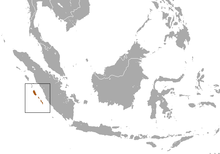Kloss's gibbon
| Kloss's gibbon[1] | |
|---|---|
| Scientific classification | |
| Kingdom: | Animalia |
| Phylum: | Chordata |
| Class: | Mammalia |
| Order: | Primates |
| Family: | Hylobatidae |
| Genus: | Hylobates |
| Species: | H. klossii |
| Binomial name | |
| Hylobates klossii (Miller, 1903) | |
 | |
| Kloss's gibbon range | |
Kloss's gibbon (Hylobates klossii), also known as the Mentawai gibbon or the bilou, is an endangered primate in the gibbon family, Hylobatidae. It is identifiable in that it is all black,[3] resembling the Siamang with its black fur, but is considerably smaller and lacks the Siamang's distinctive throat pouch. Kloss's gibbon reaches a size 44 to 63 cm and weigh at most 6 kg. As is the case for all gibbons, they have long arms and no tail.
Kloss's gibbon exclusively lives on the Mentawai Islands that lie to the west of Sumatra.[1] It is a diurnal inhabitant of the rain forest that hangs in the trees from its long arms and rarely comes to the ground. Like all species of gibbons it lives together in pairs that stake out a territory from approximately 20 to 30 hectares of size. This area is defended vehemently against other gibbons. Its diet consists mainly of fruits, occasionally also eating different plant parts, bird eggs, insects and small vertebrates.
The singing of the female Kloss's gibbon is considered the most beautiful of all the gibbons' songs. Unlike most other gibbon species (except for the Javan silvery gibbon, Hylobates moloch), Kloss's gibbon males and females do not sing duets. Males typically sing in the hour before sunrise, while an all-female chorus occurs after sunrise. The singing of the gibbons serves to warn off other animals from their territory, and possibly to strengthen the family bonds.
The reproductive cycle of Kloss's gibbon is similar to that of other gibbons. Every two to three years the female may give birth to a single young (with a gestation period of seven months). The young is weaned in the middle of its second year, and is fully mature in about seven years. Their life expectancy is about 25 years in the wild, and up to 40 years in captivity.
References
- 1 2 Groves, C.P. (2005). Wilson, D.E.; Reeder, D.M., eds. Mammal Species of the World: A Taxonomic and Geographic Reference (3rd ed.). Baltimore: Johns Hopkins University Press. p. 179. ISBN 0-801-88221-4. OCLC 62265494.
- ↑ Whittaker, D. & Geissmann, T. (2008). "Hylobates klossii". IUCN Red List of Threatened Species. Version 2008. International Union for Conservation of Nature. Retrieved 4 January 2009.
- ↑ Kloss Gibbon at the zoo
External links
| Wikispecies has information related to: Kloss's gibbon |
- ARKive - images and movies of the Kloss's gibbon (Hylobates klossii)
- Kloss Gibbon photos
- Kloss Gibbon songs
- Gibbon Conservation Center
